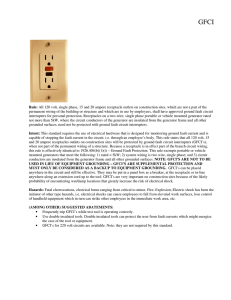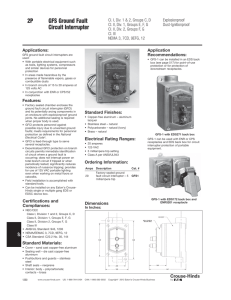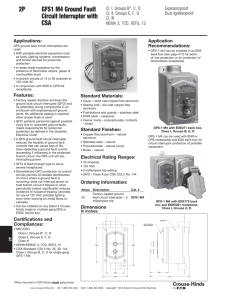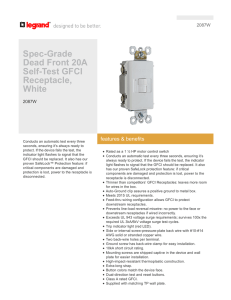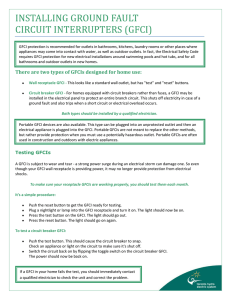gfi/gfci outlets – what you need to know!
advertisement
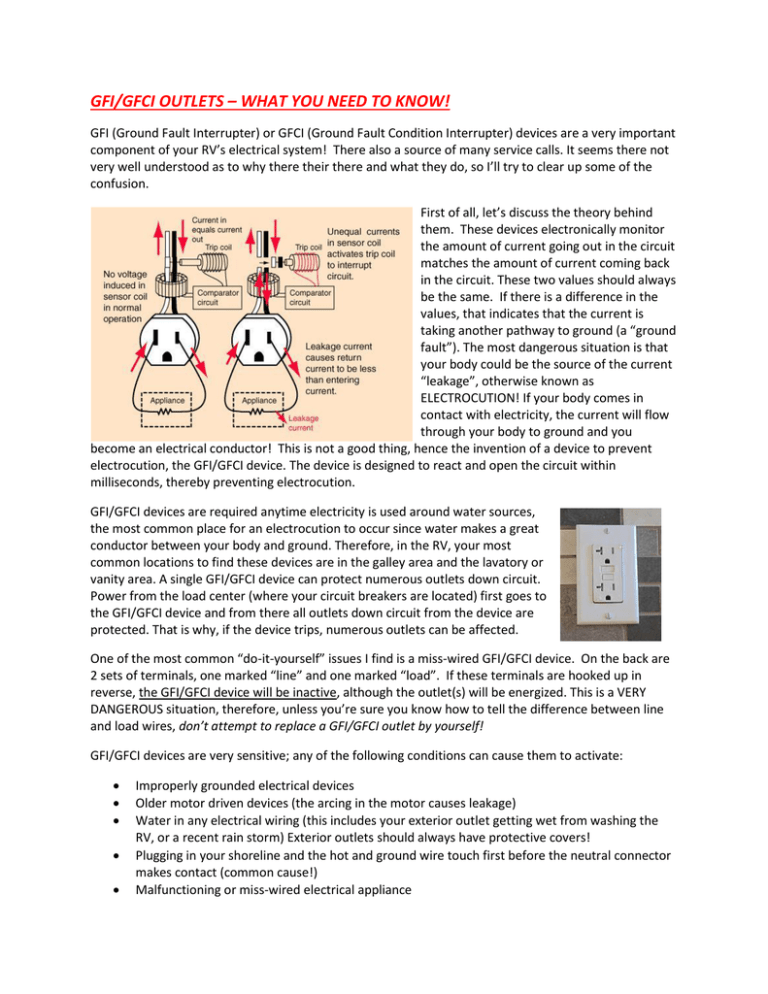
GFI/GFCI OUTLETS – WHAT YOU NEED TO KNOW! GFI (Ground Fault Interrupter) or GFCI (Ground Fault Condition Interrupter) devices are a very important component of your RV’s electrical system! There also a source of many service calls. It seems there not very well understood as to why there their there and what they do, so I’ll try to clear up some of the confusion. First of all, let’s discuss the theory behind them. These devices electronically monitor the amount of current going out in the circuit matches the amount of current coming back in the circuit. These two values should always be the same. If there is a difference in the values, that indicates that the current is taking another pathway to ground (a “ground fault”). The most dangerous situation is that your body could be the source of the current “leakage”, otherwise known as ELECTROCUTION! If your body comes in contact with electricity, the current will flow through your body to ground and you become an electrical conductor! This is not a good thing, hence the invention of a device to prevent electrocution, the GFI/GFCI device. The device is designed to react and open the circuit within milliseconds, thereby preventing electrocution. GFI/GFCI devices are required anytime electricity is used around water sources, the most common place for an electrocution to occur since water makes a great conductor between your body and ground. Therefore, in the RV, your most common locations to find these devices are in the galley area and the lavatory or vanity area. A single GFI/GFCI device can protect numerous outlets down circuit. Power from the load center (where your circuit breakers are located) first goes to the GFI/GFCI device and from there all outlets down circuit from the device are protected. That is why, if the device trips, numerous outlets can be affected. One of the most common “do-it-yourself” issues I find is a miss-wired GFI/GFCI device. On the back are 2 sets of terminals, one marked “line” and one marked “load”. If these terminals are hooked up in reverse, the GFI/GFCI device will be inactive, although the outlet(s) will be energized. This is a VERY DANGEROUS situation, therefore, unless you’re sure you know how to tell the difference between line and load wires, don’t attempt to replace a GFI/GFCI outlet by yourself! GFI/GFCI devices are very sensitive; any of the following conditions can cause them to activate: Improperly grounded electrical devices Older motor driven devices (the arcing in the motor causes leakage) Water in any electrical wiring (this includes your exterior outlet getting wet from washing the RV, or a recent rain storm) Exterior outlets should always have protective covers! Plugging in your shoreline and the hot and ground wire touch first before the neutral connector makes contact (common cause!) Malfunctioning or miss-wired electrical appliance A fault or moisture in your electrical wiring And of course, your body acting as a conductor! If your GFI/GFCI device activates, and will not reset, do not assume the device has failed, have it checked out by a professional. More than likely there is a reason it has activated verses a failed device. I have had many customers tell me they thought their GFI/GFCI outlet had failed and replaced it only to find the new device will not reset either. Finding a ground fault in a circuit requires specialized training and should be left to a professional! Some manufactures choose to protect entire circuits with a combination Circuit Breaker/GFCI device. These devices are located in your electrical load panel with the other circuit breakers and can be identified by the “TEST” button on it. Should this device trip, the paddle will be in the tripped position, just like an overload would cause. To reset this device, you must first put it in the off position then cycle it to the on position. If it trips again, you either have an overcurrent condition or a ground fault condition that needs to be determined by a professional. GFI/GFCI devices should be tested once a month. It’s a simple procedure, press the “TEST” button, the reset button should pop out (or the circuit breaker should trip if in the electrical panel). If it does not, you need to call for service immediately. Resetting is as simple as pressing the “RESET” button. If you are purchasing a used RV, it is a good idea to test the circuits down-line from the device, such as an exterior outlet. This requires a plug in GFI tester which simulates a ground fault and should trip the device. The reason it is important is that the previous owner may have replaced the device and wired it in reverse as described above. You may think that you’re protected when you are not. Some GFI outlets have indicator lights on them. Unfortunately there is no standard for what the light indicates. Some outlets have the indicator lights operating if the outlet is hot and normal operation, while some outlets the light indicates a tripped condition. Be familiar with your particular outlet. Some RV owners will put a 2 to 4 or 2 to 6 plug adapter (especially in the galley where more outlets are needed). NEVER COVER A GFI/GFCI PLUG WITH A MULTI-PLUG ADAPTOR. It may preclude the reset button from extending fully and may not break the circuit as designed. Also, if it trips, you will not see the indicator light change state. And you may forget its back there if there is a problem. So if you’re ever working near water and electricity and you feel a little tingle and hear a pop at the GFI, smile and know that that little device just saved your life! Happy & SAFE RVing! Kevin Bell Sundance Custom RV Inc. 760-408-2836
